Get ready for an exhilarating journey into the wild heart of Iowa as we explore the fascinating lives of its resident and migratory geese. From the ubiquitous Canada Goose to the seasonal spectacle of the Snow, Ross’s, Cackling, and Greater White-fronted Geese, this comprehensive guide offers a close look at the rich diversity of these waterfowl in the Hawkeye State.
Each species is brought to life through vivid photos, making it easier than ever to identify and appreciate these magnificent birds in their natural habitat.
What Geese Are in Iowa?
The geese in the state of Iowa are a beautiful sight. There are many different kinds of geese, and they can be found in nearly every part of the state. Here are the geese in Iowa:
| Goose | Frequency in Iowa | Resident Population | Specific Locations in Iowa |
|---|---|---|---|
| Canada Goose | Common | Yes | Big Creek State Park, Saylorville Lake |
| Snow Goose | Seasonal migratory birds (Spring, Fall migration) | No | DeSoto National Wildlife Refuge, Union Slough National Wildlife Refuge |
| Ross’s Goose | Seasonal (Spring, Fall migration) | No | Neal Smith National Wildlife Refuge, Hawkeye Wildlife Management Area |
| Cackling Goose | Seasonal (Spring, Fall migration) | No | Cedar Rapids Prairie Park Fishery, Rathbun Lake |
| Greater White-fronted Goose | Seasonal (Spring, Fall migration) | No | Red Rock Wildlife Area, George Wyth State Park |
Iowa is also the home to three swan species – Tundra Swan, Trumpeter Swan and Mute Swan
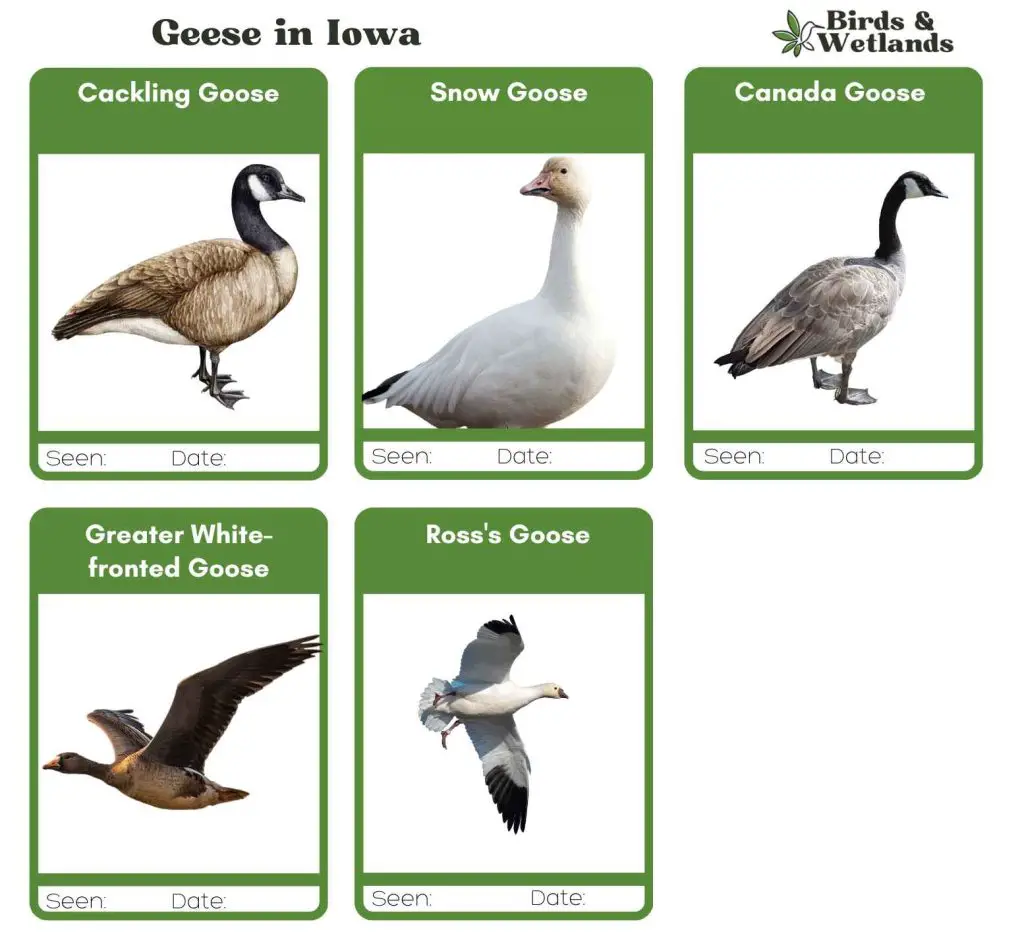
Canada Goose


Canada Goose Sound
Scientific Name: Branta canadensis
Length: 30 to 43 in
Wingspan: 50–73 in
Weight: 5.7–14.3 lb
The Canada Goose is a large, well-known species of waterfowl noted for its distinctive appearance, familiar “honk,” and migratory behavior.
Appearance: Both male and female Canada Geese have a similar appearance, featuring a black head and neck with distinctive white patches on the cheeks and chin. The body is primarily brown with a lighter, often white, underbelly.
Diet: Canada Geese primarily feed on plant matter, including grasses, aquatic vegetation, and grains. They can often be seen grazing in parks, lawns, and fields, as well as dabbling in water bodies.
Reproduction: Canada Geese typically nest on the ground near water bodies, often on islands or other isolated areas to avoid predators. The female lays a clutch of about 4 to 6 eggs, which she incubates alone for around a month.
Snow Goose

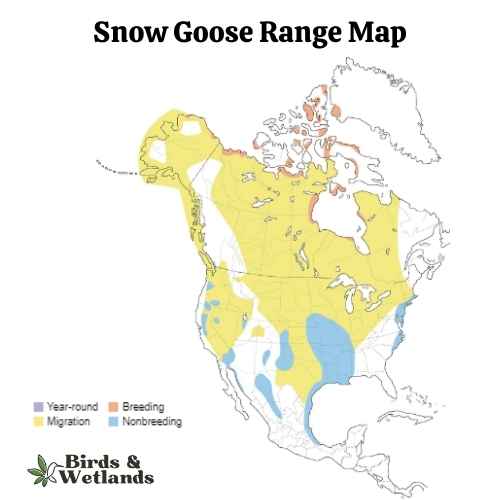
Snow Goose Sound
Scientific Name: Anser caerulescens
Length: 25 to 31 in
Wingspan: 53 to 65 in
Weight: 4.5 to 6.0
The Snow Goose is a large species of waterfowl known for its vibrant white plumage and significant migratory flights.
Appearance: True to their name, Snow Geese are predominantly white with black wingtips. They also have a pink bill, pink legs and feet. A color morph, known as the “Blue Goose,” displays a bluish-gray body with a white head, but is considered the same species.
Diet: Snow Geese primarily feed on plant matter, such as grasses, sedges, and small grains. They can often be seen in large flocks foraging in fields and marshes, and during migration and winter, they can cause considerable damage to agricultural fields due to their feeding habits.
Reproduction: Snow Geese typically nest on the tundra, near water bodies. The female builds the nest and lays a clutch of about 3 to 5 eggs, which she incubates alone for approximately three weeks. Once hatched, the goslings can feed themselves but stay with their parents for protection until they can fly.
Ross’s Goose
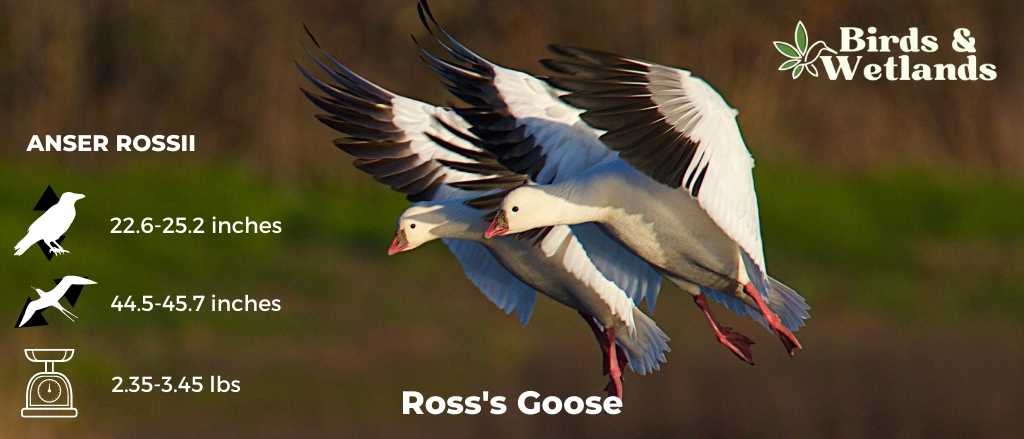
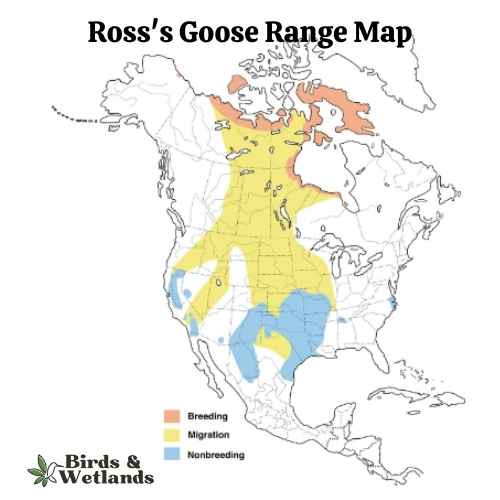
Listen
Scientific Name: Anser rossii
Length: 23.2-25.2
Wingspan: 44.5-45.7 in
Weight:42.3-55.3 oz
The Ross’s Goose is a small species of waterfowl often found in North America’s tundra and wetland habitats.
Appearance: Known for its compact size, the Ross’s Goose is mostly white with black wingtips. It features a short, stubby bill and a rounded head. One key identifying feature is the blueish gray base of its bill, which has a warty structure during the breeding season.
Diet: This goose feeds mainly on vegetation, including seeds, leaves, and roots of grasses and sedges. During winter and migration, they also consume grains and seeds from agricultural fields.
Reproduction: The Ross’s Goose nests on the ground, often in colonies. The female lays a clutch of 2 to 5 eggs which she incubates for around three weeks. The young geese, known as goslings, are precocial – they can walk, swim, and feed themselves shortly after hatching, although they stay with their parents until they learn to fly.
Cackling Goose
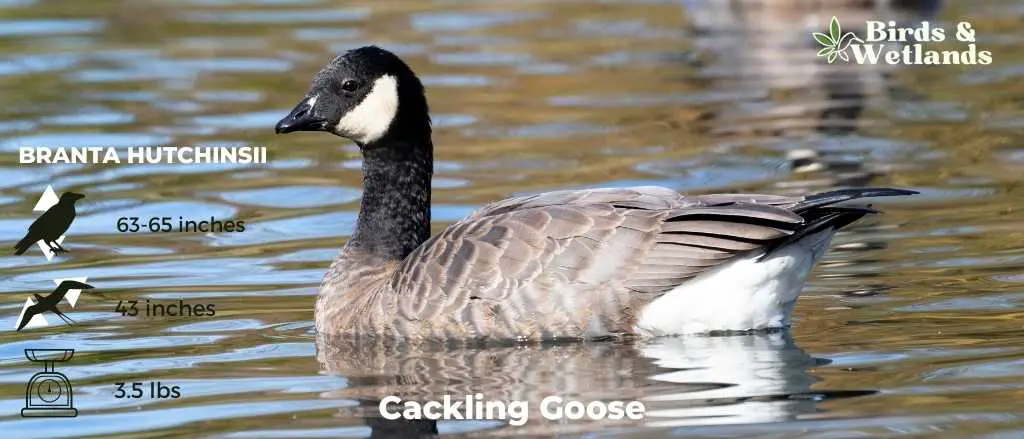
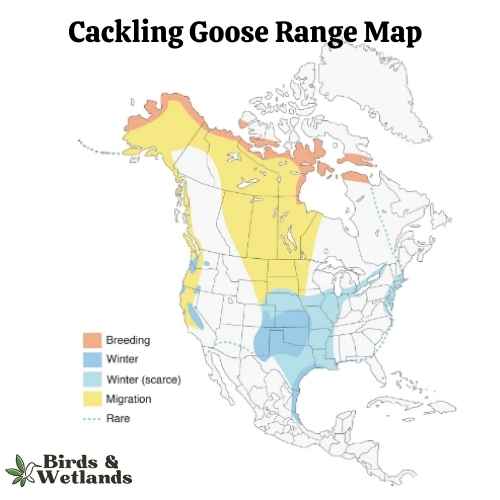
Listen
Scientific Name: Branta hutchinsii
Length: 24.8–25.6 in
Wingspan: 43-45.7 in
Weight:3.5 lbs
Cackling Geese are particularly known for their high-pitched, cackling calls, which is the source of their name. Despite their small size, these geese are renowned long-distance migrants, with some populations traveling thousands of miles between breeding and wintering grounds.
Appearance: With a similar color pattern to the larger Canada Goose, the Cackling Goose features a black head and neck, white chinstrap, light tan to cream chest, and brownish-grey body. One defining characteristic is its noticeably smaller size and stubbier neck compared to its larger counterparts.
Diet: Like many geese, the Cackling Goose’s diet mainly consists of plant matter. This includes grasses, seeds, and aquatic vegetation. They are often seen grazing on land or dabbling in shallow water.
Reproduction: Cackling Geese usually nest on the ground in elevated areas near water bodies, such as riverbanks or lakeshores. The female lays a clutch of 2 to 8 eggs and is responsible for incubation, while the male stands guard nearby. Incubation lasts for about a month.
Greater White-fronted Goose
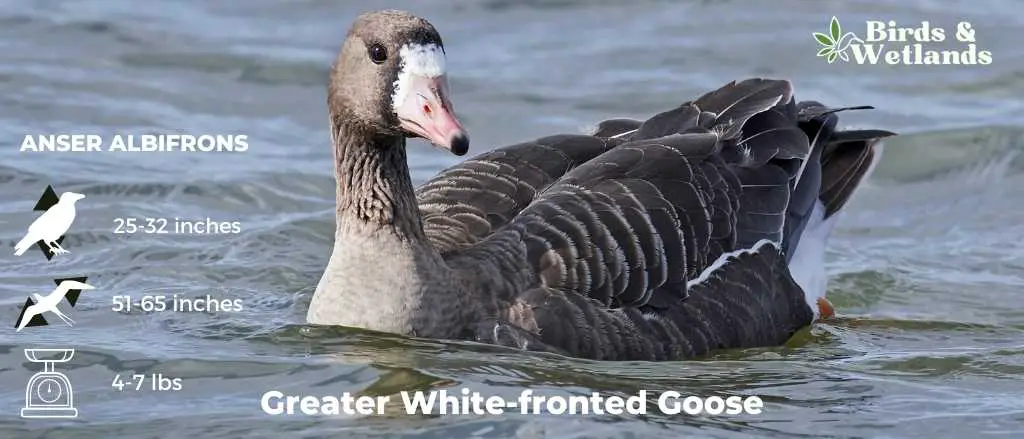

Listen
Scientific Name: Anser albifrons
Length: 25 to 31 in
Wingspan: 53 to 66 in
Weight: 3.3 to 6.6
The Greater White-fronted Goose is a medium to large waterfowl species, widely distributed across the Northern Hemisphere, particularly in North America.
Appearance: As the name suggests, these geese display a prominent white patch at the base of their bill. Their bodies are gray-brown, and their breasts are often marked with dark blotches. They possess a pinkish bill and orange legs and feet.
Diet: The Greater White-fronted Goose is a herbivore and feeds mainly on plant material. Its diet consists of grasses, sedges, grains, and berries. When wintering, these geese can often be found in agricultural fields, feasting on leftover grains and crops.
Reproduction: This species nests on the ground, often in areas with good visibility such as slopes or ridges. The female lays a clutch of 4 to 5 eggs, which she incubates for nearly a month. Once hatched, the young ones are taken care of by both parents until they are able to fly.
Are There Any Resident Flocks of Geese In Iowa?
Iowa is home to a large population of Canada geese.
While the exact numbers are unknown, it is estimated that there are tens of thousands of geese living in the state. The Canada goose is a migratory bird, so the population may fluctuate depending on the time of year.
However, Iowa does have a resident goose population that remains in the state year-round. These birds typically live near freshwater lakes and ponds, where they can find food and shelter.
Where to Spot Iowa’s Geese
Here are the top locations in Iowa known for their diversity of Geese:
Big Creek State Park, Polk City: This area is a significant habitat for waterfowl, including Canada Geese, that can be seen throughout the year.
DeSoto National Wildlife Refuge, Missouri Valley: A key migratory stop for many bird species including Snow and Ross’s Geese. They are most visible during spring and fall migrations.
Red Rock Wildlife Area, Marion County: Known for its diverse bird species. It’s a prime location to spot migrating Greater White-fronted Geese and other waterfowl.
Banded birds along the Iowa River have been tracked journeying to the Mississippi River, especially during periods of heavy snow cover. Interestingly, a significant proportion of these migrating flocks are known to traverse the landscapes of western Iowa.
Neighboring states to Iowa and their top geese-viewing locations are as follows:
- Minnesota Geese | Agassiz National Wildlife Refuge, Sherburne National Wildlife Refuge
- Wisconsin Geese | Horicon National Wildlife Refuge, Crex Meadows Wildlife Area
- Illinois Geese | Montrose Point Bird Sanctuary, Emiquon National Wildlife Refuge
- Missouri Geese | Squaw Creek National Wildlife Refuge, Eagle Bluffs Conservation Area
- Nebraska Geese | DeSoto National Wildlife Refuge, Funk Waterfowl Production Area
- South Dakota Geese | Waubay National Wildlife Refuge, Sand Lake National Wildlife Refuge
Hunting Geese in Iowa
In order to hunt geese in Iowa, you must have a valid resident or nonresident hunting license, as well as have paid the current Iowa wildlife habitat and migratory game bird fees, remember migratory game birds are protected by law and federal regulations. This is monitored by U.S. Fish and Wildlife Service and Iowa department state wildlife agencies.
Can You Shoot a Goose in Iowa?
Yes, goose hunting is allowed in the state of Iowa. You can see the daily bag and possession limits for geese in Iowa below and be in possession of federal duck stamp which you can get from Department of Natural Resources.
| Daily Bag Limit | Possession Limit | |
| Dark Geese (Canada geese, white-fronted geese, brant and any other geese that are not light geese) | 5 and may include no more than 2 Canada geese during the first segment of the statewide season and no more than 3 Canada geese during the remainder of the statewide season | Three times the daily bag limit for Canada geese, brant and white-fronted geese |
| Light Geese (white and blue-phase snow geese and Ross’ geese) | 20 | No possession limit for light geese |
Where Can I Hunt Geese in Iowa?
Geese hunting in Iowa generally takes place in the north and east portions of the state where most of the wildlife live.
The most popular areas to hunt geese include Des Moines, Cedar Rapids-Iowa City, and Waterloo-Cedar Falls zones.
Some of the lakes that offer the best hunting opportunities include Clear Lake, Storm Lake, and Black Hawk Lake.
The hunting season in Iowa is from September to January.


